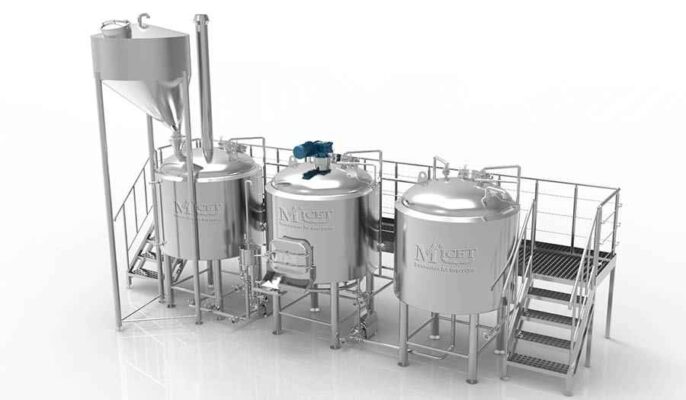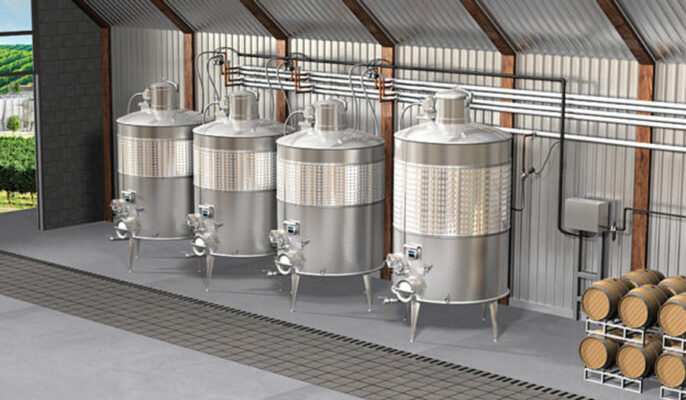Beer brewing is an intricate process that requires the right equipment to produce high quality brews. For pubs and microbreweries looking to craft their own beers on-site, having the proper brewing system is essential. This guide provides a comprehensive overview of the key equipment needed for pub beer production, from mash tuns and brew kettles to fermenters and serving tanks. We’ll explore the different types of equipment available, their key features, and how to select the right components for your brewhouse setup. Whether you’re outfitting a new pub brewery or upgrading existing equipment, use this as your go-to reference for understanding pub beer brewing hardware.
Overview of Pub Beer Brewing Equipment
Crafting beer on a pub scale requires a brewhouse setup with equipment for mashing, lautering, boiling, fermenting, conditioning, and serving. Here are the key pieces of hardware involved in pub beer production:
Table 1: Key Pieces of Pub Brewing Equipment
| Equipment | Purpose |
|---|---|
| Mash tun | Mixes milled grains with hot water to extract sugars, starches, colors, and flavors |
| Lauter tun | Separates sweet wort from spent grains |
| Brew kettle | Boils wort with hops to develop bitterness, flavor, and aroma |
| Wort chiller | Quickly cools boiled wort before fermentation |
| Fermenter | Provides closed environment for yeast to ferment sugars into alcohol and CO2 |
| Brite tank | Allows conditioning and carbonation of fermented beer |
| Glycol system | Maintains precise temperature control of fermentation and storage tanks |
| Serving tanks | Dispenses finished beer to taps while keeping oxygen exposure minimal |
Within each equipment category, pub brewers can choose from various setups and features to build a customized brewhouse. Key considerations include batch sizes, level of automation, and budget. We’ll now explore popular equipment options for each process in more detail.
Mash Tun Types for Pub Brewing
The mash tun is one of the most important vessels for influencing beer recipe development. This is where milled grains are mixed with hot water and converted into sweet wort through natural enzymes. For pub systems producing 5-15 barrel batches, here are common mash tun configurations:
Table 2: Popular Pub Brewhouse Mash Tuns
| Type | Features | Batch Size Suitability |
|---|---|---|
| Single infusion mash tun | Simple insulated vessel with mixing paddle or rake arms | Up to 10 barrels |
| Infusion mash tun with external heating | Insulated mash tun with external heat exchanger to maintain target temperature | 10-15 barrels |
| Steam-jacketed mash tun | Internal steam coils or jacket for direct heating | 10-20 barrels |
| Automated mash tun | Programmable temperature controls and automated mixing | 10-30 barrels |
- Single infusion mash tuns are economical and well-suited for pub batches under 10 barrels. They rely on a single temperature rest for starch conversion.
- External heating configurations allow better temperature control across a mash. The separate heating system provides flexibility for step mashes.
- Steam-jacketed mash tuns quickly achieve desired temperatures. But this direct heating requires vigilant monitoring to avoid scorching.
- Fully-automated mash tuns simplify multi-rest recipes. But the computerized controls come at a higher equipment cost.
Mash tun selection depends on production goals, staff skills, and budget. Small pub brewers may opt for manual operation, while larger 15+ barrel systems justify automated temperature and stirring functions.

Lauter Tun Designs for Pub Beer Production
After mashing, the grain slurry must move to a lauter tun for wort separation. Filtering sweet wort from spent grains is vital for efficiency and avoiding stuck mashes. Pub-scale lauter tun options include:
Table 3: Pub Brewhouse Lauter Tun Styles
| Type | Method | Advantages | Disadvantages |
|---|---|---|---|
| Grant | Batch sparging | Simple, manual operation | Slow wort collection |
| False bottom | Fly sparging | Faster runoff, better efficiency | Prone to channeling |
| Slotted manifold | Fly sparging | Even wort distribution | Potential to overflow |
| Rotating racking arm | Fly sparging | Self-leveling collection | Complex, expensive |
- Grants rely on multiple batch sparges. These compact manual systems are ideal for small pub installations.
- False bottom lauter tuns have slots that distribute sparge water. Helpful for 5-10 barrel systems.
- Slotted manifolds improve flow distribution for efficient fly sparging. Popular for 10-15 barrel batches.
- Rotating racking arms self-adjust to collect the clearest wort. Advanced feature for 15 barrel+ automated brewhouses.
Ideally, the lauter tun size matches the mash tun capacity for seamless transfers. Consider ease of operation and maintenance when selecting a sparging setup.
Brew Kettle Options for Pub Beer Production
The brew kettle is the heart of the brewhouse where wort from the lauter tun gets boiled with hops. Kettles must be sized appropriately for each batch and have features to support recipe goals. Pub brew kettles typically range from 5-30 barrels with direct or indirect heating:
Table 4: Pub Brewhouse Kettle Types
| Type | Heating Method | Batch Size Suitability |
|---|---|---|
| Direct fire kettles | Gas burner below kettle | 5-15 barrels |
| Steam-jacketed kettles | Enclosed steam coils | 10-30 barrels |
| External kettle boiler | Pumped hot water circulation | 15-60 barrels |
- Direct fire kettles are affordable and heat quickly. But they require monitoring to prevent scorching.
- Steam-jacketed kettles evenly distribute heat. Condensate must be drained to prevent boil overs.
- External boilers provide the most precision temperature control for large batches. Requires pumping hot water to the kettle.
Other key brew kettle features include bottom drainage valves, heating ramp controllers, automatic mixing, and programmable recipe profiles. Kettles should be constructed of stainless steel.
Essential Pub Brewery Ancillary Equipment
In addition to the core mash, lauter, and kettle vessels, pub breweries need various other ancillary equipment for production:
Table 5: Critical Pub Brewery Ancillary Equipment
| Equipment | Purpose |
|---|---|
| Mill | Crushes malt grains for mashing |
| Heat exchanger | Boosts temperature of sparge water |
| Whirlpool | Separates hops and coagulated proteins from wort |
| Wort chiller | Quickly cools boiled wort before fermentation |
| Pumps | Transfers liquids between vessels |
| Piping | Moves liquids around the brewery |
| Gauges and sensors | Monitor flow rates, pressures, and temperatures |
| Cleaning and sanitation | Cleans and sanitizes equipment |
Proper sizing of these supporting items prevents bottlenecks. Consider upgrade potential when selecting pumps, piping, controls, etc. Pick equipment constructed of durable, non-reactive stainless steel. Prioritize ease of maintenance and inspection.
Fermentation and Serving Equipment
After wort production comes fermentation and storage. Pub breweries require specialized equipment for this stage as well:
Table 6: Fermentation and Serving Vessel Equipment
| Equipment | Purpose | Key Features |
|---|---|---|
| Yeast propagation | Grows yeast for pitching | Temperature control, aeration |
| Fermenters | Provides closed environment for primary fermentation | Temperature control, variable pressure release |
| Brite tanks | Allows secondary fermentation, clarification, and carbonation | Pressure rating, glycol cooling, carbonation stone |
| Serving tanks | Dispenses finished beer with minimal oxygen pickup | Glycol jacket, high pressure rating, beer out post, sight glass |
Proper fermenter and brite tank sizing prevents bottlenecking batch workflow. Jacketed, stainless steel vessels with programmable temperature control and pressure relief deliver the most flexibility. Serving tanks require sound construction to maintain carbonation and prevent oxygen ingress.

Key Considerations for Selecting Pub Brewing Equipment
When outfitting a pub brewery, keep these guidelines in mind for choosing equipment:
Table 7: Pub Brewery Equipment Selection Criteria
| Factor | Reasoning and Tips |
|---|---|
| Production goals | Size equipment based on target batch sizes and annual barrelage. Allow room to grow. |
| Budget | Weigh capital costs against labor savings of automation. Start semi-automated and upgrade later. |
| Ingredient flexibility | Seek equipment accommodating various mash schedules, recipes, and beer styles. |
| Quality and consistency | Pick sturdy stainless steel components that are easy to clean, maintain, and calibrate. |
| Staff skills | Balance manual operation against cost of automated controls. Prioritize user-friendly. |
| Physical space | Carefully measure floorspace and prioritize compactness. Consider height for gravity flow. |
| Upgrades | Select equipment with upgrade potential. Oversize motors, pumps, and piping. Choose modular. |
Take time to test equipment and train staff before full production. Prioritize quality, efficiency, and consistency when engineering your pub brewhouse. Carefully designed equipment is essential for crafting great beer.
FAQ
Q: What size mash tun do I need for a 10 barrel pub brewery?
A: For a 10 barrel brewhouse, a 10-15 barrel mash tun allows adequate room for mash liquor and grains. Oversize your mash tun volume by 50-100% compared to batch sizes.
Q: Should I choose manual or automated pub brewing equipment?
A: It depends on your budget and staff skills. Semi-automated equipment with programmable pumps and temperature controls provide a good balance for many pub brewers starting out. You can upgrade to more automation later as production increases.
Q: What material should pub brewing equipment be constructed from?
A: Stainless steel is by far the best material for durability, cleanliness, and corrosion resistance. Many alloys are available, including 304, 316, and high-nickel alloys. Pick at least 304 stainless for good value and performance.
Q: How many fermenters and brite tanks do I need for pub-scale production?
A: Plan for at least three fermenters and two brite tanks per 10 barrels of production capacity. This allows one batch to ferment while another batches conditions and a third serves. Utilize conicals for combined fermentation and conditioning.
Q: Should I lease or buy new pub brewing equipment?
A: Purchasing equipment provides the most control and customization for growth. But leasing can conserve capital in early years. Weigh the benefits – newer gear and warranties with buying vs. lower startup costs with leasing.
Q: Where can I find good deals on pub brewing equipment packages?
A: Check for used deals from other breweries upgrading systems. Or look for equipment package deals from reputable suppliers. Joining the Brewers Association provides access to the trading post and classifieds.
Q: What maintenance is required on pub brewing equipment?
A: Daily and weekly cleaning and sanitizing is critical. Inspect fittings, gaskets, hoses regularly. Lubricate valves and seals. Calibrate sensors annually. Major maintenance comes every few years – repassivating stainless, replacing gaskets, servicing motors.
Q: Should I upgrade to automated brewing equipment?
A: Automating recipe control, temperature management, mixing, and transferring can improve consistency and free up labor once dialed in. Carefully evaluate costs against potential benefits for your brewhouse setup and staff.




